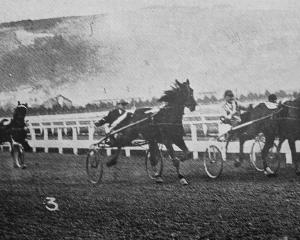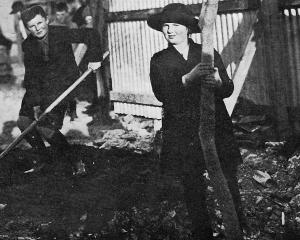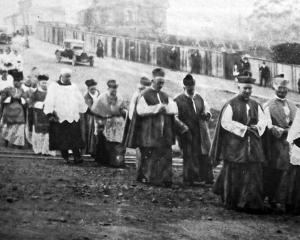The men left Wellington about 10 a.m. on Saturday week, and that day covered 23 miles, which is a very creditable performance.
After the first day an average of 16 miles per day was covered.
On Friday they arrived at Palmerston after a 98 miles' trek.
The transport wagons, which included a special vehicle carrying the Roberts' travelling cooker, arrived about 11.30.
The horses and men, although tired, looked little the worse for their long march.
The main body arrived about 12.10, after ''attacking'' Palmerston, via the Manawatu bridge.
During the march, 15 specialists, who are mounted on fine horses, did practical manoeuvring work on the hills and surrounding country.
In order to minimise the transport work all the forage and quantities of stores, etc., were sent from Wellington by rail, and were picked up at different points along the road.
On Thursday the battery was inspected near Shannon by Colonel Robin, who expressed himself as very pleased with the general appearance and physique of the men.
On Friday night the men camped on the show grounds, and left for Wellington on Saturday.
• During the hearing of a land case at the Supreme Court at Christchurch on Tuesday it was stated (says the Lyttelton Times) that a block of land had been described by the seller as aggregating 48 acres, and advertised by the agents as 50 acres.
His Honor: How do you explain the discrepancy?
The witness explained that agents frequently altered the area slightly in order that neighbours should not know that the property was for sale.
Frequently people did not like to have it known that they were endeavouring to sell out.
His Honor: You put an incorrect area in the newspapers and trust to putting the correct area to the buyer when he comes in?
Witness: That is the practice to a certain extent.
His Honor: To what extent do you consider it advisable to ''cook'' advertisements?
Witness: Three, four, or five acres, as a rule.
• The protection of New Zealand scenic reserves was discussed by Mr H. G. Ell, M.P., with the Hon. A. L. Herdman, Minister of Justice, during his recent visit to Wellington.
Mr Ell has now received from the Minister a letter stating that instructions have now been issued to the police to pay particular attention to the scenic reserves in their respective districts, with a view to preventing people from lighting fires or damaging trees, shrubs, or plants in the reserves.
• That the oyster season is in was evident by the numerous Australian visitors by the Paloona at Bluff on Wednesday, who thronged the refreshment rooms (says the Southland Times).
The fame of the Bluff product had gone far afield, and the visitors were emphatic in their praise of the size and excellence of the Southland variety.
In comparison the famous Sydney ''rock'' oyster suffered.
One fair young voyager, who had staked her reputation on eating two dozen before seeing the Straits' article, discounted the bet when the dish ''on the shell'' was placed before her.
They were, she said, ''too great for anything''.
An oyster-opening record has been established at Bluff.
Mr W. J. Newman opened five sacks of oysters on Monday in five hours, which he claims is a New Zealand record.
Five sacks contain 4200 oysters, and the opening rate works out at 14 oysters per minute. - ODT, 8.3.1915.
• COPIES OF PICTURE AVAILABLE FROM ODT FRONT OFFICE, LOWER STUART ST, OR WWW.OTAGOIMAGES.CO.NZ












